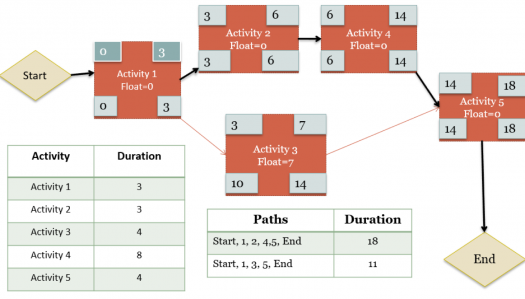Important Questions On Project Time Management!

Are you looking for some important questions on project time management? There are a lot of activities that are undertaken when it comes to accomplishing a project, and having a time set where each activity is to be finished has the power not only to increase productivity but effectiveness too. Take the questions below and get to see what more you may learn about ability.
- 1.
Project Time Management defines how schedule contingencies will be reported and assessed.
- A.
True
- B.
False
Correct Answer
B. FalseExplanation
Project Time Management does not specifically define how schedule contingencies will be reported and assessed. It focuses on activities such as defining activities, sequencing them, estimating their durations, and developing a schedule. Reporting and assessing schedule contingencies fall under the domain of Project Risk Management. Therefore, the correct answer is False.Rate this question:
-
- 2.
Which relationship type matches the following definition: "The successor can't start before the predecessor has started."
- A.
Finish to Start
- B.
Start to Start
- C.
Finish to Finish
- D.
Start to Finish
Correct Answer
B. Start to StartExplanation
The relationship type that matches the given definition is "Start to Start." This means that the successor activity cannot start until the predecessor activity has started. In other words, both activities must start at the same time or have a delay between their starts. This relationship ensures that the successor activity is dependent on the start of the predecessor activity.Rate this question:
-
- 3.
Define ________: Identifying and documenting the actions to be performed to produce the deliverables.
Correct Answer
Activities - 4.
Which of the following is NOT a component of Develop Schedule?
- A.
Activity list
- B.
Schedule network analysis
- C.
Project schedule
- D.
Expert judgement
Correct Answer
D. Expert judgementExplanation
Expert judgement is not a component of Develop Schedule because it is a technique used in various project management processes, including Develop Schedule, to gather input and insights from experts in order to make informed decisions. However, it is not a specific component or output of the Develop Schedule process itself. The other options listed (activity list, schedule network analysis, and project schedule) are all components of the Develop Schedule process, as they are directly involved in creating and finalizing the project schedule.Rate this question:
-
- 5.
If start and finish dates are not realistic, project will most likely not finish as scheduled. Sure or false?
- A.
True
- B.
False
Correct Answer
A. TrueExplanation
If the start and finish dates of a project are not realistic, it means that the project is not properly planned and scheduled. This lack of realistic timeframes can lead to delays, resource constraints, and other issues that can prevent the project from finishing as scheduled. Therefore, it is likely that the project will not be completed on time if the start and finish dates are not realistic.Rate this question:
-
- 6.
This is an example of a Critical ________ Diagram.
Correct Answer
PathExplanation
This is an example of a Critical Path Diagram. A critical path diagram is a project management tool that shows the sequence of activities and the estimated duration of each activity. It helps identify the critical path, which is the longest sequence of activities that determines the project's overall duration. By analyzing the critical path, project managers can identify potential bottlenecks and prioritize activities to ensure the project is completed on time.Rate this question:
- 7.
Calculate the Activity Duration for a project with a work quantity of 450 computers and a production rate of 50 computers/day.
- A.
10 days
- B.
5 days
- C.
2 days
- D.
9 days
Correct Answer
D. 9 daysExplanation
The activity duration for the project can be calculated by dividing the work quantity (450 computers) by the production rate (50 computers/day). This will give us the number of days required to complete the work. In this case, 450 divided by 50 equals 9, so the activity duration is 9 days.Rate this question:
-
- 8.
Sequence Activities is the process of identifying and documenting relationships among the project activities. True or false?
- A.
True
- B.
False
Correct Answer
A. TrueExplanation
Sequence Activities is indeed the process of identifying and documenting relationships among project activities. This process involves determining the logical order in which activities should be performed to achieve project objectives. By establishing these relationships, project managers can create a project schedule that ensures activities are executed in the right sequence, minimizing delays and optimizing resource utilization. Therefore, the correct answer is true.Rate this question:
-
- 9.
Check the options which are Tools & Techniques found in Estimate Activity Resources.
- A.
Expert judgement
- B.
Alternative analysis
- C.
Activity resource requirements
- D.
EEF's
- E.
PM Software
- F.
OPA's
- G.
Bottom-up estimating
- H.
Published estimated data
Correct Answer(s)
A. Expert judgement
B. Alternative analysis
E. PM Software
G. Bottom-up estimating
H. Published estimated dataExplanation
The tools and techniques found in Estimate Activity Resources include expert judgement, alternative analysis, PM software, bottom-up estimating, and published estimated data. Expert judgement refers to the input and insights provided by individuals with specialized knowledge and experience in the field. Alternative analysis involves evaluating different options and approaches to estimate activity resources. PM software is used to assist in the estimation process. Bottom-up estimating involves breaking down the work into smaller components and estimating the resources required for each component. Published estimated data refers to industry-specific data or historical records that can be used as a reference for estimating resources.Rate this question:
-
Quiz Review Timeline +
Our quizzes are rigorously reviewed, monitored and continuously updated by our expert board to maintain accuracy, relevance, and timeliness.
-
Current Version
-
Nov 16, 2023Quiz Edited by
ProProfs Editorial Team -
Dec 28, 2017Quiz Created by
Marchesl
 Back to top
Back to top



